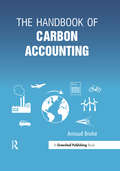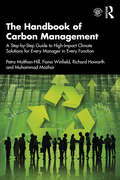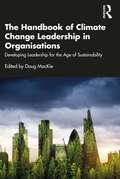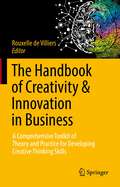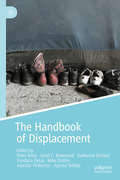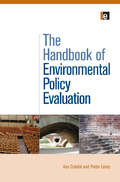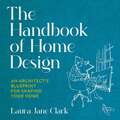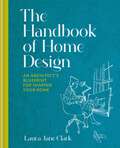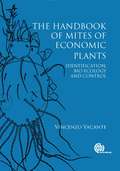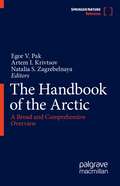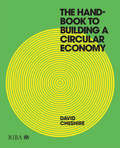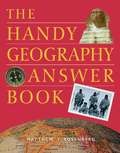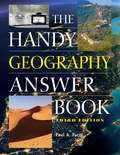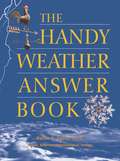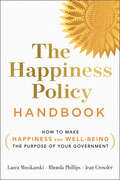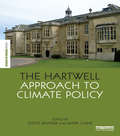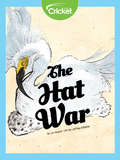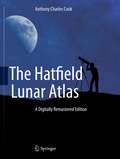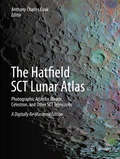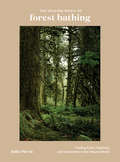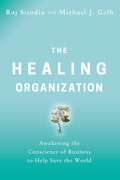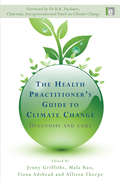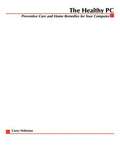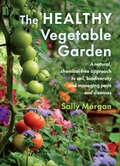- Table View
- List View
The Handbook of Carbon Accounting
by Arnaud BrohéCarbon Accounting is a vital tool in enabling organisations to measure and report on their greenhouse gas emissions. As the need to respond to the causes and impacts of climate change becomes increasingly urgent, emissions calculations and inventories are a vital first step towards mastering climatic risk. The Handbook of Carbon Accounting offers an accessible and comprehensive presentation of the discipline. The book examines the different methods or instruments implemented by countries and companies – such as carbon taxation, carbon markets and voluntary offsetting – while revealing how these stem not simply from the aim of reducing emissions for the lowest cost, but more as a compromise between divergent interests and individual world views. It also explores the historical context of the emergence of carbon accounting, assessing its evolution since the Rio Conference in 1992 and the signing of the Kyoto Protocol in 1997, to the latest Conference of Parties in 2015 in Paris.The book concludes with a very practical guide to calculate, reduce, offset and disclose your carbon footprint.Like other management tools, carbon accounting may not be an exact science, but its contribution has never been more important. The Handbook of Carbon Accounting is a vital educational resource that will help readers – including those with no prior knowledge of the field – to understand carbon flows and stocks and to take action. It forms part of a movement that heralds the start of a new economic era in which the search for prosperity can live in harmony with the environment.
The Handbook of Carbon Management: A Step-by-Step Guide to High-Impact Climate Solutions for Every Manager in Every Function
by Petra Molthan-Hill Fiona Winfield Richard Howarth Muhammad MazharEvery manager and every employee in every function can embed climate solutions and reduce greenhouse gas emissions. This book, written by experts in the field of sustainability in business, shows you how. The climate crisis is one of the greatest challenges we face today, and it affects all aspects of business and society. Consequently, everyone needs to know the best high-impact climate solutions that can be embedded into their organisational area. In this book you will find ideas for your team, your department and your organisation to make this a reality. We provide you with implementation plans and inspiring case studies, with practical and helpful tools that will help you to scale up climate solutions effectively and efficiently. If you are an owner of a company or an executive in any organisation, you will benefit from this step-by-step guide on how to set up your own greenhouse gas management plan, how to set targets and how to reduce the greenhouse gas emissions of your whole organisation. We explain key terms such as Net Zero, Carbon Neutral, carbon emissions equivalents and the three scopes. In order to halve our emissions worldwide by 2030 to achieve Net Zero by 2050, individual actions on a large scale are required, but also systemic changes. We look at the bigger picture in this book and also how you could effect change. This is the first book to offer an easy-to-implement approach to decarbonise organisations and transform societies, and is appropriate for managers at any level. This book can also be used in business schools to inspire future managers and business leaders. Last, but not least, everyone can find ideas here that they can implement in their personal lives – let’s scale up together!
The Handbook of Climate Change Leadership in Organisations: Developing Leadership for the Age of Sustainability
by Doug MacKieClimate change is one of the most significant and challenging problems we face today, and many organisations have recognised their responsibility in reducing emissions and environmental degradation and regenerating biodiversity. However, conventional leadership has failed to respond adequately to the magnitude of the threat, and a profound change in corporate leadership is required to substantively cut emissions and change climate policy to minimise further destructive environmental impact. This book sets out the qualities and approaches needed by leaders to successfully develop and implement climate change mitigation and adaptation policies. Bringing together the foremost experts in climate change leadership from business, leadership, psychology and coaching backgrounds, this book addresses the failures of current leadership practice and proposes a variety of models of how climate change leadership capabilities can be effectively developed in organisations. It is structured around four concepts: foundations, which includes models of environmental, ecological and evolutionary leadership; transitions, which looks at transformational and ethical models that are being repurposed for the age of sustainability; progressions, which explores innovative models that are being developed for the current age including systems, adaptation and maturity-based models of leadership; and actions, which includes models of sustainable goal setting and climate leadership coaching and development. The book is written for corporate leaders, researchers and educators and will be an invaluable addition to the leadership curriculum and executive development programmes to help the next generation of leaders respond to global challenges.
The Handbook of Creativity & Innovation in Business: A Comprehensive Toolkit of Theory and Practice for Developing Creative Thinking Skills
by Rouxelle De VilliersThis book enables readers to develop their own creative thinking and their teams' creative problem-solving skills to generate novel, useful and surprising ideas. The vast majority of companies believe that a culture of innovation and renewal impacts performance and ultimately business results. In contrast, many managers feel ill-equipped to promote a culture of creative endeavour for this type of work-environment and lack the know-how to put it into practice. This book covers theory, practice, and impact metrics of both convergent and divergent thinking tools and provide managers with the ideas, tools and guidance to develop a corporate culture conducive to intrapreneurial thinking, idea creation and testing and moving inventions from ideas to viable business concepts, products and profitable innovations. This book includes numerous step-by-step tutorials to help the reader to learn concepts quickly.
The Handbook of Displacement
by Vandana Desai Peter Adey Katherine Brickell Janet C. Bowstead Mike Dolton Alasdair Pinkerton Ayesha SiddiqiThis Handbook provides the knowledge and tools needed to understand how displacement is lived, governed, and mediated as an unfolding and grounded process bound up in spatial inequities of power and injustice. The handbook ensures, first, that internal displacements and their everyday (re)occurrences are not overlooked; second, it questions ‘who counts’ by including ‘displaced’ people who are less obviously identifiable and a clearly circumscribed or categorised group; third, it stresses that while displacement suggests mobility, there are also periods and spaces of enforced stillness that are not adequately reflected in the displacement literature; and fourth, it re-evokes and explores the ‘place’ in displacement by critically interrogating peoples’ ‘right to place’ and the significance of placemaking, unmaking, and remaking in the contemporary world. The 50-plus chapters are organised across seven themes designed to further develope interdisciplinary study of the technologies, journeys, traces, governance, more-than-human, representation, and resisting of displacement. Each of these thematic sections begin with an intervention which spotlights actions to creatively and strategically intervene in displacement. The interventions explore myriad meanings and manifestations of displacement and its contestation from the perspective of displaced people, artists, writers, activists, scholar-activists, and scholars involved in practice-oriented research. The Handbook will be an essential companion for academics, students, and practitioners committed to forging solidarity, care, and home in an era of displacement.
The Handbook of Environmental Policy Evaluation
by Ann Crabb Pieter LeroyPolicy evaluation is an important and well-established part of the policy process, facilitating and feeding back to promote the ongoing effectiveness of policies that have been implemented or anticipating policies in the making. Environmental policy is a special case, presenting new complexities uncommon to other areas, which standard evaluation tools are ill-equipped to grapple with. It is also an area that is experiencing rapid growth throughout the world and knowledge is now needed at all levels of government and in NGOs, businesses and other organizations, all of whom are required to assess the effectiveness of their policies. This handbook is the first guide to environmental policy evaluation in practice. Beginning with an introduction to the general principles of evaluation, it explains the particular complexities native to the environmental sphere and provides a comprehensive toolkit of evaluation methods and techniques which the practitioner can employ and refer to again and again. The authors also consider design issues which may face the policy evaluator, including involvement of stakeholders, the sensitivities between them, the a priori assessment of the evaluability of a field, the maximization of the utilization of the evaluations outcomes, and much more. Throughout, the theory is illustrated with practical examples from around the world, making this the essential companion guide for anyone tasked with ensuring that environmental policy fulfils its aims and achieves its potential.
The Handbook of Home Design: An Architect’s Blueprint for Shaping your Home
by Laura Jane ClarkArchitectural solutions & designs to optimize the spaces in your home without spending a fortune.Architect Laura Jane Clark, from the BBC and Netflix smash-hit series Your Home Made Perfect, has spent over 15 years designing, remodelling, and building homes with budgets that range from modest to enormous. THE HANDBOOK OF HOME DESIGN distils Laura's wealth of experience and enthusiasm giving you an accessible yet detailed guide to design, empowering you with the tools and knowledge to shape your home how you want. Throughout your home design journey, whether large or small, Laura takes you each step of the way from understanding your home, reading a plan and writing a brief, right through to sketching your own design and having the confidence to get what you want on the building site. Packed full of tips and tricks, inspiration and technical know-how, THE HANDBOOK OF HOME DESIGN is like having Laura by your side, showing you how to design practical yet beautiful spaces, get more storage into your life and create the home of your dreams.Laura Jane Clark wants to democratize the whole concept of residential architectural design and empower you to redesign your spaces by giving you the language and ability to confidently communicate your vision, get the most out of your design and ultimately love your finished home. Whether you are a long-term homeowner, first-time buyer or simply visualising your dream space, no matter what your budget is, this unique insight into Laura's process allows you to achieve both the design you want and the home you need.www.lamparchitects.co.uk Instagram: @laurajaneclark_(p) 2023 Octopus Publishing Group
The Handbook of Home Design: An Architect’s Blueprint for Shaping your Home
by Laura Jane ClarkArchitectural solutions & designs to optimize the spaces in your home without spending a fortune.Architect Laura Jane Clark, from the BBC and Netflix smash-hit series Your Home Made Perfect, has spent over 15 years designing, remodelling, and building homes with budgets that range from modest to enormous. THE HANDBOOK OF HOME DESIGN distils Laura's wealth of experience and enthusiasm giving you an accessible yet detailed guide to design, empowering you with the tools and knowledge to shape your home how you want. Throughout your home design journey, whether large or small, Laura takes you each step of the way from understanding your home, reading a plan and writing a brief, right through to sketching your own design and having the confidence to get what you want on the building site. Packed full of tips and tricks, inspiration and technical know-how, THE HANDBOOK OF HOME DESIGN is like having Laura by your side, showing you how to design practical yet beautiful spaces, get more storage into your life and create the home of your dreams.Laura Jane Clark wants to democratize the whole concept of residential architectural design and empower you to redesign your spaces by giving you the language and ability to confidently communicate your vision, get the most out of your design and ultimately love your finished home. Whether you are a long-term homeowner, first-time buyer or simply visualising your dream space, no matter what your budget is, this unique insight into Laura's process allows you to achieve both the design you want and the home you need.www.lamparchitects.co.uk Instagram: @laurajaneclark_
The Handbook of Home Design: An Architect’s Blueprint for Shaping your Home
by Laura Jane ClarkArchitectural solutions & designs to optimize the spaces in your home without spending a fortune.Architect Laura Jane Clark, from the BBC and Netflix smash-hit series Your Home Made Perfect, has spent over 15 years designing, remodelling, and building homes with budgets that range from modest to enormous. THE HANDBOOK OF HOME DESIGN distils Laura's wealth of experience and enthusiasm giving you an accessible yet detailed guide to design, empowering you with the tools and knowledge to shape your home how you want. Throughout your home design journey, whether large or small, Laura takes you each step of the way from understanding your home, reading a plan and writing a brief, right through to sketching your own design and having the confidence to get what you want on the building site. Packed full of tips and tricks, inspiration and technical know-how, THE HANDBOOK OF HOME DESIGN is like having Laura by your side, showing you how to design practical yet beautiful spaces, get more storage into your life and create the home of your dreams.Laura Jane Clark wants to democratize the whole concept of residential architectural design and empower you to redesign your spaces by giving you the language and ability to confidently communicate your vision, get the most out of your design and ultimately love your finished home. Whether you are a long-term homeowner, first-time buyer or simply visualising your dream space, no matter what your budget is, this unique insight into Laura's process allows you to achieve both the design you want and the home you need.www.lamparchitects.co.uk Instagram: @laurajaneclark_
The Handbook of Mites of Economic Plants
by Vincenzo VacanteMites pose a serious problem to plants worldwide, attacking crops and spreading disease. When mites damage crops of economic importance the impacts can be felt globally. Mites are among the most diverse and successful of invertebrates, with over 45,000 described species, with many more thousands to be discovered. They are responsible for a significant portion of the losses of crops for food, fibre, industry and other purposes, and require expensive and often controversial pest control measures. Understanding these mites is vital for entomologists, pest researchers, agronomists and food producers. Knowledge of mite pests helps to inform control strategies and optimize the production of economic plants and the agrarian economy. This encyclopedia provides a thorough coverage of the mites and the problems they cause to crops, yet it is easily searchable, organised by mite species and subdivided into helpful headings. It takes a worldwide view of the issue of mites injurious to economic plants, describing mites prevalent in different regions and discussing control methods appropriate in different environments. This book provides an encyclopaedic reference to the major mites, described by family in terms of their internal and external morphology, bio-ecology and family systematics. Methods of mite collection and laboratory study is described, as well as species diagnostic characteristics, worldwide distribution, host plants, identification by the type of damage they cause and control strategies, including chemical and biological intervention and integrated pest management measures. Mites of the following families are included: (Eriophyoidea, Tarsonemidae, Tuckerellidae, Tenuipalpidae, Tetranychidae, Acaridae, Penthaleidae). Mites of Economic Plants is an important resource for students of entomology and crop production, and as a thorough reference guide for researchers and field workers involved with mites, crop damage and food production.
The Handbook of the Arctic: A Broad and Comprehensive Overview
by Egor V. Pak Artem I. Krivtsov Natalia S. ZagrebelnayaThis book offers a broad and holistic overview of issues in the Arctic today, a region which is transforming due to changing world order and climate agenda. While new economic opportunities - and with China, as well as other geopolitical players in the region - are emerging, new security challenges are arising as well. In this comprehensive scholarly resource, contributors from around the world and from a broad variety of disciplines share their thoughts on the future of the Arctic, in a manuscript that will be of interest to researchers, economists, and policymakers.
The Handbook to Building a Circular Economy
by David CheshireThis book is a call to arms to all architects, designers and built environment professionals. To avoid a climate catastrophe and achieve a regenerative built environment, the use of new materials and any excess waste in resources need to be cut out from the very beginning of the design process. This requires far-reaching change in established industry processes. How might this begin? What are the key fundamentals you need to know? How can a more effective model be applied? This book, a much-updated second edition of the author’s previous work Building Revolutions, answers all your questions. Inspiring, but never overwhelming, the Handbook to Building a Circular Economy is your must-have companion to helping create a more sustainable future. It explains in simple and practical terms how the principles of a circular economy can be applied to the built environment, thereby reducing the resources required to construct, fit-out, maintain and refurbish buildings. Case studies include: The Forge, UK, by Landsec The Bath School of Art, UK, by Grimshaw Urban Mining and Recycling Experimental Unit, Switzerland, by Werner Sobek NASA Sustainability Base, USA, by William McDonough + Partners University of East Anglia Enterprise Centre, UK, by Architype Park 20|20, The Netherlands, by William McDonough + Partners.
The Handy Geography Answer Book
by Paul A Tucci Mathew Todd RosenbergAn expert on the unexplained and paranormal research, Brad and Sherry Steiger turn their unique and remarkable talents to the bold storytelling of encounters with the unknown from throughout the ages. From mysterious strangers and unpredictable beings to weird behavior and paranormal phenomena, they investigate claims of visits from ghastly ghosts, otherworldly creatures, aliens living among us, phantoms, spirits and other accounts of encounters with the unexplained. Over 130 astounding accounts of Real Encounters with the supernatural, such as ... *Visitors from others worlds who have had Earth under surveillance for centuries, conducting their activities in secret-- even abducting humans for their own research and undeclared ends. *Members of secret societies who developed an advanced technology centuries ago which has been kept hidden in underground or undersea cities. *Time Travelers from the Future. Beings who claim to be our descendents from the future who are returning to study the true destiny of humankind. *Ghosts that haunt people, places, and things--and poltergeists that create havoc. *Beasties and monsters found in everyone's worst nightmares--and sometimes in their campsites, fields, and yards. *Other Dimensional Visitors, Beings, Creatures, or Entities that come not from a faraway world in our solar system or any other, but from an adjacent space-time continuum existing on another vibrational/dimensional frequency or level. *Previously unknown, unidentified terrestrial life-forms, such beings as "sky-critters," "sky fish," "rods," and "orbs." *As yet unknown physical energies that may be activated by the psyche, the unconscious level of the human mind. *Archetypal creatures and entities of the collective unconscious that are the result of energies that are accessible through dreams, meditations, and other states of altered consciousness. *Interactions with beings that have been dubbed elves, fairies, devas throughout the centuries. *The marvelous, creative facet of dreams. *Out-of-body mind-traveling through Time and Space. *Majestic beings who are described in the scriptures of many world religions as angels or demons.
The Handy Geography Answer Book
by Paul A TucciGeography is more than just maps and finding your destination. It is about the land, the people on that land, the delicate balance of nature, and our very interdependence upon it, despite the miracles of technology and grocery stores. It's about the effects of nature on places and people, as well as how politics, borders, cities, and towns affect our lives. The Handy Geography Answer Book traces the history of geography from Eratosthenes and Alexander von Humboldt to latitude and longitude, and the latest advances in the Global Positioning System (GPS). It provides insights into economic, social, historic, culture, religious, political, and climate geography, plus oceanography, demographics, and more.Completely revised and updated, it tours the world, its natural features, and the ever-changing mark humans make on our planet, answering 1,200 questions from the trivia (longest, hottest, tallest) to how geography has influenced history, religion, architecture, and the location of cities, including Who first had the idea that there is a magnetic North Pole? What is interesting about Google's "Streetview"? How many people are projected to live on the planet in 2050? Which state has the highest annual divorce rate? What are the largest and smallest counties in the U.S.?
The Handy Weather Answer Book
by Kevin HileFully updated with the latest advances in meteorology as well as an additional section on climate change, this comprehensive reference addresses all aspects of weather in an accessible questionandanswer format. All the basic elements of weather are discussed, as are all types of weather phenomena and the science of forecasting. In addition, the relationships between weather and oceanography, geology, and space science are expertly covered. Included are more than 1,000 questions and answers such as, Has a hurricane ever struck southern California? Could our oceans have originated in space? and What is bioclimatology? This resource is an ideal reference for students, teachers, and amateur meteorologists.
The Happiness Policy Handbook: How to Make Happiness and Well-Being the Purpose of Your Government
by Rhonda Phillips Laura Musikanski Jean CrowderBuild a better society through happiness policyThomas Jefferson said that “the purpose of government is to enable the people of a nation to live in safety and happiness.” Yet only now, 270 years later, is the happiness of citizens starting to be taken seriously as the purpose of government.While happiness science is advancing rapidly, and governments and organizations are creating indices for measuring happiness, there is little practical information on how to create policy to advance happiness.Drawing from a deep well of expertise and experience, The Happiness Policy Handbook is the first step-by-step guide for integrating happiness into government policy at all levels. Coverage includes:A concise background on happiness science, indices and indicators, and happiness in public policyTools for formulating happiness policy and integrating happiness into administrative functionsA concept menu of happiness policiesCommunicating happiness policy objectives to media and engaging with the communityA happiness policy screening tool for evaluating the happiness contribution of any policyPolicy perspectives from seasoned experts across sectors.The Happiness Policy Handbook is the essential resource for policymakers and professionals working to integrate happiness and well-being into governmental processes and institutions.
The Hartwell Approach to Climate Policy (The Earthscan Science in Society Series)
by Steve Rayner Mark CaineThe Hartwell Approach to Climate Policy presents a powerful critique of mainstream climate change policies and details a set of pragmatic alternatives based on the Hartwell Group’s collective writings from 1988-2010. Drawing on a rich history of heterodox but increasingly accepted views on climate change policy, this book brings together in a single volume a series of key, related texts that define the ‘Hartwell critique’ of conventional climate change policies and the ‘Hartwell approach’ to building more inclusive, pragmatic alternatives. This book tells of the story of how and why conventional climate policy has failed and, drawing from lessons learned, how it can be renovated. It does so by weaving together three strands of analysis. First, it highlights why the mainstream approach, as embodied by the Kyoto Protocol, has failed to produce real world reductions in greenhouse gas emissions and delayed real meaningful progress on climate change. Second, it explores the underlying political, economic, and technological factors which form the boundary conditions for climate change policy but which are often ignored by policy makers and advocates. Finally, it lays out a novel approach to climate change guided centrally by the goal of uplifting human dignity worldwide—and the recognition that this can only succeed if pursued pragmatically, economically, and with democratic legitimacy. With contributions from leading scholars in the field, this work presents a original critique of climate policy and a constructive primer for how to improve it.
The Hat War
by Liz HuyckHave you ever seen a feather in a hat? A long time ago, they were very fashionable. Some people would even put whole birds on their hats! To get the feathers, though, the birds had to be hunted. Learn about the women who fought to change laws in the name of conservation!
The Hatfield Lunar Atlas
by Anthony Cook"The Hatfield Lunar Atlas" has become an amateur lunar observer's bible since it was first published in 1968. A major update of the atlas was made in 1998, using the same wonderful photographs that Commander Henry Hatfield made with his purpose-built 12-inch (300 mm) telescope, but bringing the lunar nomenclature up to date and changing the units from Imperial to S.I. metric This edition is important since the fact is that modern telescope optics, digital imaging equipment and computer enhancement can easily surpass what was achieved with Henry Hatfield's 12-inch telescope and a film camera. This limits the usefulness of the original atlas to visual observing or imaging rather small amateur telescopes. The new, digitally re-mastered edition vastly improves the clarity and definition of the original photographs - significantly beyond the resolution limits of the photographic grains present in earlier atlas versions - while preserving the layout and style of the original publications. This has been achieved by merging computer-visualized Earth-based views of the lunar surface, derived from NASA's Lunar Reconnaissance Orbiter data, with scanned copies of Commander Hatfield's photographic plates, using the author's own software. The results is a "The Hatfield Lunar Atlas" for 21st century amateur telescopes up to and beyond 12-inch aperture.
The Hatfield SCT Lunar Atlas
by Anthony Charles CookIn 2004, it became obvious that Henry Hatfield's original atlas wasn't suitable for all current commercially-made amateur telescopes. Newtonian telescopes and astronomical refractors - for many years the only choice for amateurs - invert the observed image. The standard Hatfield Atlas therefore follows the IAU (International Astronomical Union) convention of having maps (and photographs) with South at the top and West on the left: an inverted image. However, the current ranges of Schmidt-Cassegrain and Maksutov telescopes - that's most of those manufactured by Meade, Celestron, and many others - don't invert the observed image but instead reverse it left-for-right. That's with North at the top and East on the left. Because of the way the human visual system works, it is almost impossible to mentally 'mirror-image' a map to compare it with the view through the eyepiece , so even turning an IAU-standard atlas upside-down doesn't help! This new SCT version of the Atlas solves this problem for observers. Identification of lunar features is made quick and easy. The new, digitally re-mastered second edition vastly improves the clarity and definition of the original photographs - significantly beyond the resolution limits of the photographic grains present in earlier atlas versions - whilst preserving the layout and style of the original publications. This has been achieved by merging computer-visualized Earth-based views of the lunar surface, derived from NASA's Lunar Reconnaissance Orbiter data, with scanned copies of Commander Hatfield's photographic plates, using the author's own software. The result is a The Hatfield SCT Lunar Atlas for 21st century amateur telescopes up to and beyond 12-inch aperture. It contains all the features that made the original so widely used: a combination of an index of all International Astronomical Union named primary lunar features, and twelve chart areas help to locate any named lunar features of interest that can each be examined under typically five different states of illumination. Close ups of interesting features are also included. The new Atlas is supplemented by an introduction to its use, a short description of the digital re-mastering technique, and a completely new section describing lunar observing techniques. At the end of the atlas there is an index of all named features and crater diameters, along with a summary table of the dates and times that the original Hatfield images represent.
The Healing Magic of Forest Bathing: Finding Calm, Creativity, and Connection in the Natural World
by Julia PlevinAn engaging guide to the art of forest bathing, inspired by the Japanese practice of shinrin-yoku, for anyone who wants to explore the transformative power of nature in promoting health and happiness. Forest bathing is the art of spending intentional time in nature and is practiced throughout the world to increase health and restore well-being. More and more people are turning to forest bathing as an evidence-based way to unplug, relieve stress and anxiety, and spark creativity. Through simple invitations to slow down, walk in silence, cultivate tree energy, and connect with the sun and forest, this book enables you to incorporate the inspiring benefits of time spent in nature—a calm mind, renewed energy, boosted creativity, and inner peace—into your daily life to find deeper meaning and contentment.
The Healing Organization: Awakening the Conscience of Business to Help Save the World
by Michael J. Gelb Raj SisodiaThe image of modern corporations has been shaped by a profits over people approach, but we are at a point where business must take the lead in healing the crises of our time. The Healing Organization shows how corporations can become healing forces.Conscious Capitalism pioneer Raj Sisodia and organizational innovation expert Michael J. Gelb were inspired to write this book because of the epidemic of unnecessary suffering connected with business, including the destruction of the environment; increasing numbers living paycheck-to-paycheck and barely surviving; and rising rates of depression and stress leading to chronic health problems.Based on extensive in-depth interviews and inspiring case studies, Sisodia and Gelb show how companies such as Shake Shack, Hyatt, KIND Healthy Snacks, Eileen Fisher, H-E-B, FIFCO, Jaipur Rugs and DTE Energy are healing their employees, customers, communities and other stakeholders. They represent a diverse sampling of industries and geographies, but they all have significant elements in common, besides being profitable enterprises:Their employees love coming to work.They have passionately loyal customers.They make a significant positive difference to the communities they serve.They preserve and restore the ecosystems in which they operate.The enmity and dividedness between those who champion unfettered capitalism and those who advocate socialism is exacerbating rather than solving our problems.In a world that urgently needs healing on many levels, this is a movement whose time has come. The Healing Organization shows how it can be done, how it is being done, and how you can begin to do it too.
The Health Practitioner's Guide to Climate Change: Diagnosis and Cure
by Jenny Griffiths Fiona Adshead Mala Rao Allison ThorpeHighly commended in the Public Health category, BMA Medical Awards 2010 There are enormous health benefits from tackling climate change. This is the first book to set out what health practitioners can do to prevent the worst impacts of climate change, to make health services sustainable, and to design healthy, sustainable communities. The book: - provides an introduction for health practitioners and students to climate change and its current and future health impacts - describes the relationship between health and the environment - gives facts and figures on greenhouse gas emissions - sets out the huge benefits to health of acting on climate change - explains what health practitioners can do - at home, at work and in their organizations, and - shows how you can support action in communities, nationally and globally. Essential reading for: - health professionals, local government, built environment professionals - students across all sectors of health, medicine and public administration - community and voluntary sector, NGOs - the business community involved in private healthcare. The Health Practitioner's Guide to Climate Change is written by an authoritative group of authors from key organisations in the field, including the Met Office, the Faculty of Public Health, Natural England, the London School of Hygiene and Tropical Medicine, the Climate and Health Council, the NHS Sustainable Development Unit, the Health Protection Agency, the University of the West of England, Sustrans and the National Social Marketing Centre. Sponsored by The National Heart Forum and the National Social Marketing Centre. Foreword by Dr. R.K. Pachauri, Director General, The Energy and Resources Institute (TERI) and Chairman, Intergovernmental Panel on Climate Change (IPCC)
The Healthy PC: Preventive Care and Home Remedies for Your Computer
by Robert J. Shimonski Carey HolzmanLearn routine maintenance as well as desktop basics, hard drive care and defragmentation, and plenty more to make your PC more efficient and keep it running smoothly. Learn software management, tame the Internet, secure your machine, deal with downloads, and much more.
The Healthy Vegetable Garden: A natural, chemical-free approach to soil, biodiversity and managing pests and diseases
by Sally MorganWhether you’re an experienced gardener, homesteader, or market farmer, this A–Z, soil-to-table guide shows you how to reduce chemical inputs; naturally enrich your growing ecology; and create a hardy, nutrient-dense, and delicious crop. "There are few gardeners (or farmers) I know who wouldn’t benefit from reading Sally Morgan’s new book. . . . The Healthy Vegetable Garden is a detailed and indispensable resource."—Hobby Farms In The Healthy Vegetable Garden, expert organic gardener Sally Morgan explains how to use natural approaches to cope with the challenges of a changing climate through principles from regenerative gardening, agroecology, and permaculture—all to help your green space thrive. The Healthy Vegetable Garden shows you how to: Combat disease and keep pests at bay with natural predators, companion planting, and trap and barrier crops Choose the right plants to attract pollinators and pest predators Build a healthy soil full of organic matter, earthworms, and mycorrhizal fungi Regenerate soil through no-dig practices, composting, cover crops, and mulching Boost biodiversity through the use of crop rotations and polyculture Rewild your garden by creating a range of habitats, making use of walls and fences, log piles, water features, and wild corners Understand plant defenses and use biocontrols Make natural barriers, traps, and lures A healthy, productive garden should work in harmony with nature to produce and protect delicious fruits and vegetables and build a rich soil that is full of life. With The Healthy Vegetable Garden, growers of all levels will start reducing incidents of pests and diseases while creating a verdant habitat—all without the need for fertilizers, pesticides, or weedkillers.
